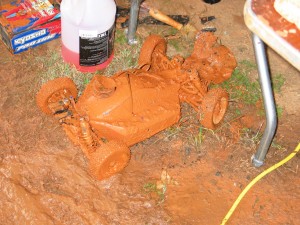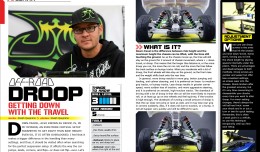King of the Mud!
Words: Paul King
Photos: Paul King
Flip Magazine Live Link
https://vrcmag.com/free_articles/vrc_014_king_of_mud/#/1/
Prep your car for wet-weather racing
If you race a lot, and especially if you travel to races or race iFMAR-sanctioned events, you will inevitably have to run in wet weather. Depending on how hardcore your track is, you may run in rain or shine. In Europe, there is a lot of wet-weather racing, and you can see this in how they design their tracks with pavement, wood, and AstroTurf. In this article, I’ll give you all the tips you’ll need to master wet racing and become the undisputed Sultan of Sleet, Master of Mud, Leader in the Liquid, or Maharajah of the Monsoon!
Radio
First things first. If you are running in wet conditions, naturally, the focus turns immediately to the electronics. Receivers and LiPos don’t like water, and they need to stay dry! You’ll need balloons or plastic baggies for your battery and receiver. Stretch a balloon or plastic bag over the receiver or battery, and use rubber bands to hold them over the wires and keep the water out. In addition to the balloons, you’ll want to use Shoe Goo on any openings in your radio box. Wherever your servo wires go into the radio box, you will need to seal it with Shoe Goo.

Spur gear
I learned this small trick from Mick Craddock at the 2008 Worlds in North Carolina. For very wet or flooded conditions, you will need a small piece of Lexan over the spur gear. To do this, remove the center diff and then cut a piece of Lexan to the right shape to form a fender above the spur gear. This prevents the spur from spraying water all over the inside of your car, including onto your air filter. After you’ve cut the Lexan to the correct shape, screw your splash guard into place on the diff mount above the spur gear. You can get creative with this, but a simple, flat piece aligned properly will work just fine.

Springs and ride height
In the mud, you will need much stronger springs and taller ride height. At the beginning of your run, it will be stiff and rigid on the track, but as the mud collects, the ride height will become lower and after a couple of laps, you’ll realize the car is working really well. Don’t be shy in a mud bog; use the stiff springs, and crank up the ride height. Your car will probably weigh about 15 or 20 pounds when it comes off the track. How much spring would you need for a 20-pound car?

Tape it!
Duct tape is very useful, especially for extremely muddy conditions. The most important place for it is over the fuel tank inlet. It helps keep the mud and water out of the body shell and the area around the fuel tank lid. If applied properly, it will help keep dirt and water out of the fuel tank when you open it. To do this, you’ll have to make a couple of flaps out of duct tape and then stick them to the body. If you do this right, the flap will open when you pull on the fuel tank lid and then close again when you let go. Other important areas to tape are around the body, taping the body shell to the side guards, the shock towers, and the webbing on the suspension arms. Yuichi Kanai is a master at this. He regularly applies tape to the suspension arms to keep mud out of the webbing.


WD40 is your friend
Once you’ve completed all the waterproofing and taping, you can pretty much go crazy with the WD40 on the underside of the chassis and on the body. If your pit man uses WD on the car before your run, it will be much easier to clean. If your car gets transformed into a submarine during your race, you will also want to soak it in WD40 (after you’ve washed it off) to prevent everything from rusting.

Tires
For muddy, wet conditions, you will want small pins and narrow wheels, if possible. And of course, softer compounds should be used. For extreme conditions, you can even narrow the entire wheel. You can do this by trimming the wheel and then cutting out a strip of rubber in the center of the tire, then gluing it back together again. If you’ve never done this before, you can learn from an experienced tire guru. Again, this should be used only in extreme mud/bog conditions.

Air filter
Running in the rain requires a special filter. Kyosho makes a good wet-weather filter (part number 92304) that has a shield on the outside to keep the sponge dry. If you don’t have this specific filter, a lot of guys get creative with plastic bottles or other things to build a shield. Anything that will cover the sponge and protect it from water while allowing airflow will work.

Last resort: lose the wing

If there is a lot of sticky mud, it can be smart to remove the wing completely. If it gets caked with mud, you’ll find that the car works better without a wing at all. This is for extreme conditions where you are basically mud-bogging your way around the track.
Well I think that about covers mud running. In a total mud bog it sometimes comes down to who’s car keeps running, so the air cleaner and tune could win the race for you. In severe adverse weather focus on finishing that race as the main goal.
Thanks for reading and drive happy.- PK

















